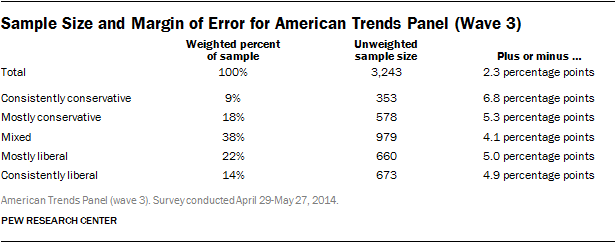About the American Trends Panel
The American Trends Panel (ATP), created by the Pew Research Center, is a nationally representative panel of randomly selected U.S. adults living in households. Respondents who self-identify as internet users (representing 89% of U.S. adults) participate in the panel via monthly self-administered Web surveys, and those who do not use the internet participate via telephone or mail. The panel is being managed by Abt SRBI.
Data in this report are drawn from the May wave of the panel, conducted April 29-May 27, 2014 among 3,243 respondents (2,906 by web and 337 by mail). The margin of sampling error for the full sample of 3,243 respondents is plus or minus 2.3 percentage points.
All current members of the American Trends Panel were originally recruited from the 2014 Political Polarization and Typology Survey, a large (n=10,013) national landline and cellphone random digit dial (RDD) survey conducted January 23rd to March 16th, 2014, in English and Spanish. At the end of that survey, respondents were invited to join the panel. The invitation was extended to all respondents who use the internet (from any location) and a random subsample of respondents who do not use the internet.[1]
Of the 10,013 adults interviewed, 9,809 were invited to take part in the panel. A total of 5,338 agreed to participate and provided either a mailing address or an email address to which a welcome packet, a monetary incentive and future survey invitations could be sent. Panelists also receive a small monetary incentive after participating in each wave of the survey.
The ATP data were weighted in a multi-step process that begins with a base weight incorporating the respondents’ original survey selection probability and the fact that some panelists were subsampled for invitation to the panel. Next, an adjustment was made for the fact that the propensity to join the panel varied across different groups in the sample. The final step in the weighting uses an iterative technique that matches gender, age, education, race, Hispanic origin and region to parameters from the U.S. Census Bureau’s 2012 American Community Survey. Population density is weighted to match the 2010 U.S. Decennial Census. Telephone service is weighted to estimates of telephone coverage for 2014 that were projected from the January-June 2013 National Health Interview Survey. It also adjusts for party affiliation using an average of the three most recent Pew Research Center general public telephone surveys, and for internet use using as a parameter a measure from the 2014 Survey of Political Polarization. Sampling errors and statistical tests of significance take into account the effect of weighting. The Hispanic sample in the American Trends Panel is predominantly native born and English speaking. In addition to sampling error, one should bear in mind that question wording and practical difficulties in conducting surveys can introduce error or bias into the findings of opinion polls.
The Web component of the May wave had a response rate of 61% (2,906 responses among 4,740 Web-based individuals enrolled in the panel); the mail component had a response rate of 61% (337 responses among 553 non-Web individuals enrolled in the panel). Taking account of the response rate for the 2014 Survey of Political Polarization (10.6%), the cumulative response rate for the May ATP wave is 3.5%.
The accompanying table shows the unweighted sample sizes and the error attributable to sampling that would be expected at the 95% level of confidence for selected groups discussed in the report.

Ideological consistency used throughout this report is based on a scale composed of 10 questions asked on Pew Research Center surveys going back to 1994 to gauge peoples’ ideological worldview. The questions cover a range of political values including attitudes about size and scope of government, the social safety net, immigration, homosexuality, business, the environment, foreign policy and racial discrimination.
The scale is designed to measure how consistently liberal or conservative people’s responses are across these various dimensions of political thinking (what some refer to as ideological ‘constraint’). Note that where people fall on this scale does not always align with whether they think of themselves as liberal, moderate or conservative. (See here for more details on the relationship between self-identification and placement on this scale). Full details can be found in Appendix A of ��Political Polarization in the American Public.”
[1] When data collection for the 2014 Political Polarization and Typology Survey began, non-internet users were subsampled at a rate of 25%, but a decision was made shortly thereafter to invite all non-internet users to join. In total, 83% of non-internet users were invited to join the panel.


 Interactive
Interactive